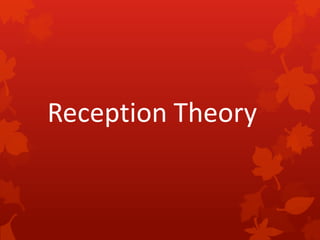Reception theory (1)
Reception theory focuses on how the audience perceives and interacts with a work of art or media. It was originally a method for literary criticism but can be applied to other art forms like film. Reception theory explains that meaning comes from the interaction between the audience and the work, not from the work itself. The theory is relevant when creating media for both passive and active audiences, who will have different levels of engagement. Uses and gratification theory also examines audience reception but looks at why people choose certain media and what needs they fulfill, such as identity, education, entertainment, or social interaction. Understanding audience reception is important for creating successful products targeted at both active and passive groups.

Recommended
Recommended
More Related Content
What's hot
What's hot (20)
Similar to Reception theory (1)
Similar to Reception theory (1) (20)
More from Alysia Hurrell
More from Alysia Hurrell (12)
Reception theory (1)
- 2. • Reception theory is the idea that recognises that the audience are an essential element in the creative process. It was originally a method of literary criticism. Reception theory explains that the meaning does not lie in the work of art itself but the meaning is part of the process of interaction between the audience and the artwork. It can be applied to many art forms such as drama, film and painting. • In literary studies, reception theory originated from the work of HansRobert Jauss in the late 1960s. • Reception theory focuses on how the audience will perceive what they are looking at and this applies to my work as I will have to focus on two different audiences, passive and active. • The active audience will apply to my digipak as it is something the audience will go out looking for whereas the magazine advert has a passive audience where it will have to grab the audiences attention because the audience aren't looking for it it’ll be there and have to make them want to stop and look at it.
- 4. • Uses and gratification theory is a way of understanding why and how people seek out specific media to satisfy specific needs. Uses and gratification is an audience-centered approach to understanding mass communication. Unlike other media effect theories that question “what do media do to the people?”, uses and gratification theory focuses on “what do people do with media?” • It is suggested that uses and gratification theory has o fulfil one of the following when we chose a form of media: Identity, being able to recognise the product or person in front of you, role moels that reflect similar values to yours, aspiration to be someone else. Educate, being able to acquire information, knowledge and understanding. Entertain, what you are consuming should give you enjoyment and also some form of ‘escapism’ enabling us to forget our worries temporarily. Social interaction, the ability for media products to produce a topic of conversation between other people, speakers debates. • This theory links to our work because we need to understand how our audience is going to react to our work it also is going to shape our planning due to the fact that we’re working towards two different audience receptions: active and passive. Therefore our focus groups for the ancillary tasks will vary to represent the different active and passive audience types. Without this our products will not be successful meaning our video would also fail its purpose.
